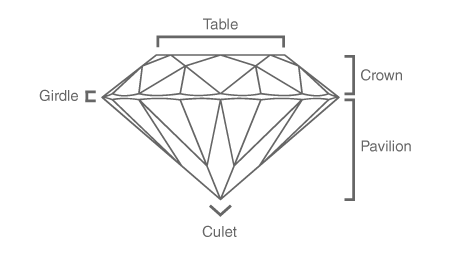In a continuing celebration of the diamond being April’s birthstone, we forge ahead with our Know Your Diamonds blog series. In part 4, we examine what most experts consider to be the most important of the four C’s: diamond cut. When many people think of diamond cut, they are actually thinking of a diamond’s shape. Diamond cut determines the gemstone’s proportions, and these proportions create brilliance, fire, and scintillation– also known as a diamond’s sparkle.
The Most Important of the Four C’s
In the diamond industry, a diamond’s cut is widely considered to be the most important aspect. Diamond cut will greatly affect how a diamond sparkles as well as the diamond’s carat weight. In order to keep the maximum weight of the mined rough diamond, most diamonds are “spread” when cut. The result of spreading creates a heavier diamond. However, this technique sacrifices the potential fire and brilliance of the stone. Therefore, the diamond could potentially have less sparkle, especially to the naked eye. The way light enters and exits the diamond depends heavily on the cut because the width and depth have the greatest effect on how light travels within the diamond. The light exiting the diamond is also affected. Both shallow cuts and deep cuts have specific characteristics.
Shallow Cuts and Deep Cuts
When diamonds have shallow cuts, light leaks out of the bottom. Unfortunately brilliance is lost, and the diamond appears dark or watery. A shallow cut diamond with these characteristics is referred to as a “fisheye”. On the other hand, in diamonds with deep cuts, light leaks out of the sides. This means brilliance is lost, and the center of the diamond will appear to be dark. A diamond with these characteristics is referred to as a “nailhead”. When a diamond has an ideal cut, it will retain the maximum amount of light, resulting in a more brilliant diamond.
Grading A Diamond’s Cut
There are several measurements used to grade a diamond’s cut. Two key factors in grading diamond cut are known as depth percentage and table percentage. Depth percentage measures the height of the diamond against the width of the gemstone. To calculate table percentage, a gemologist would take a measurement of the diameter of the top facet of the gemstone against the average width of the diamond. The GIA or AGSL grading reports that accompany every loose diamond from Adiamor list these percentages.
While different gem experts possess differing opinions on the best table size and the best depth for a diamond, these two factors are not enough to fully grade a diamond’s cut. A number of other factors contribute to the overall diamond cut quality, including crown angle, culet size, girdle thickness, polish, and symmetry.
Thanks for checking in on our current installment of the Know Your Diamonds series. For more information on diamonds, visit the Adiamor Education Center.

